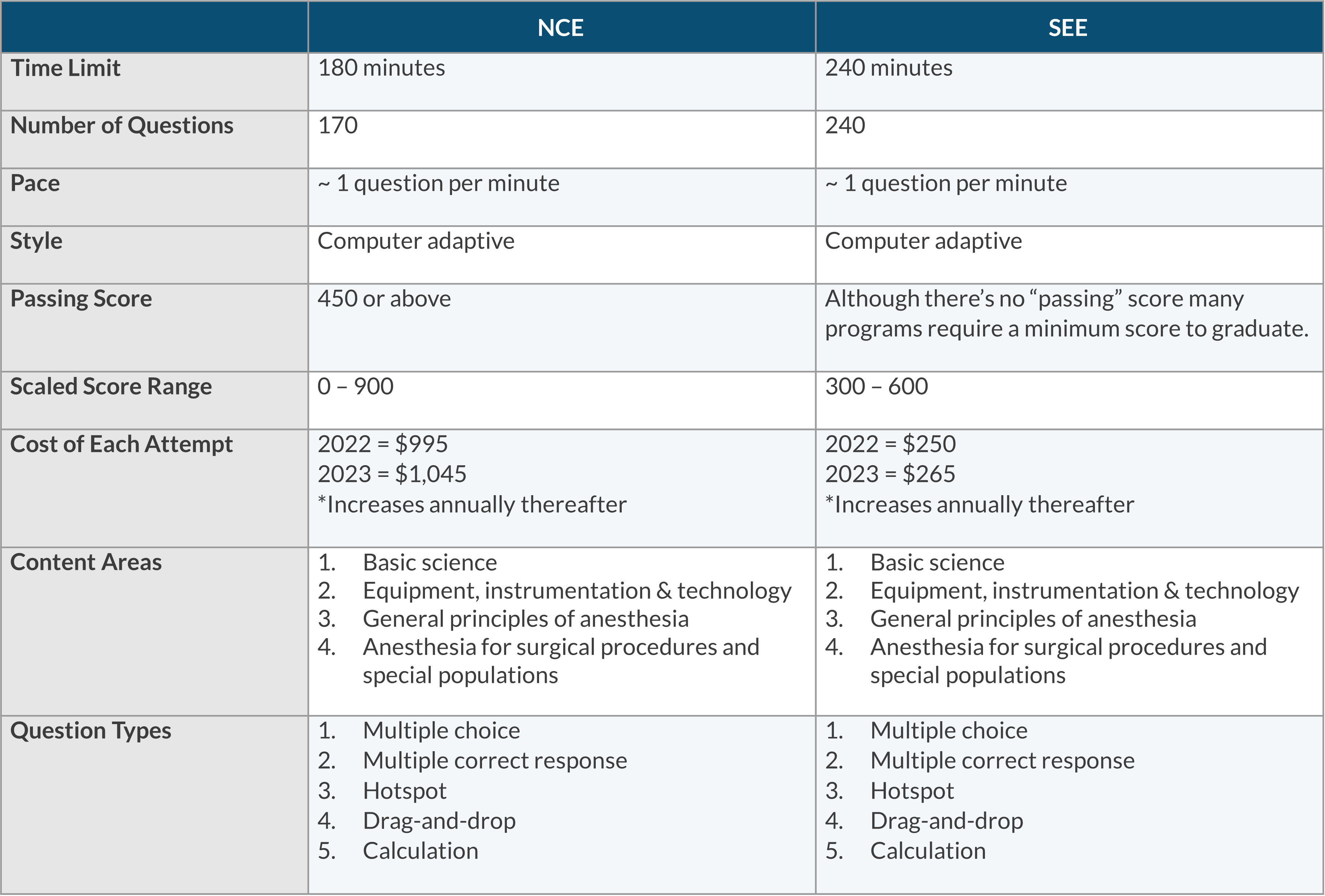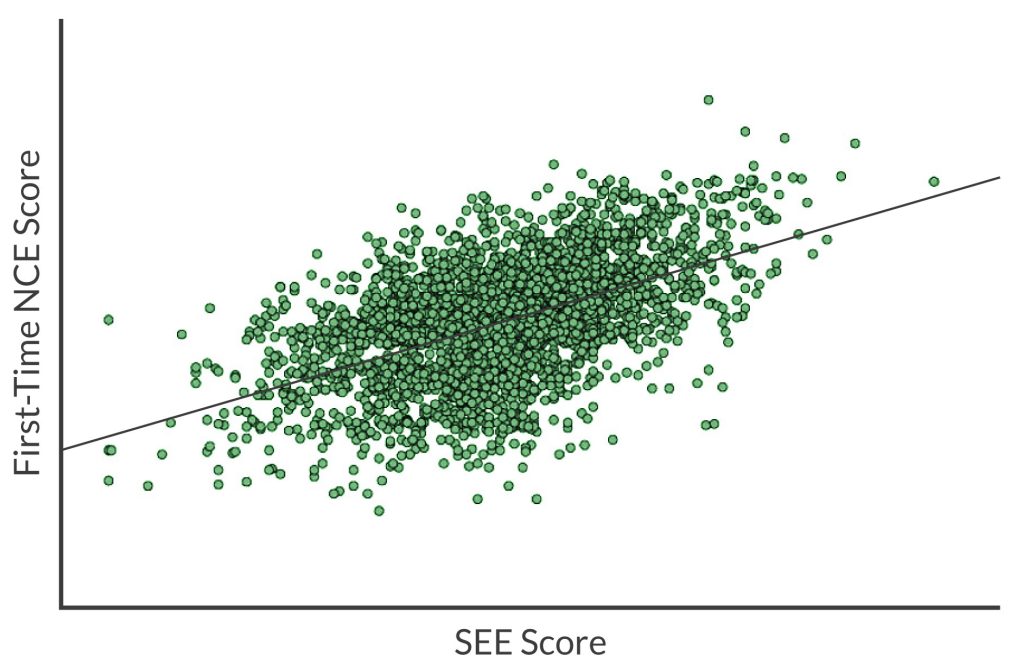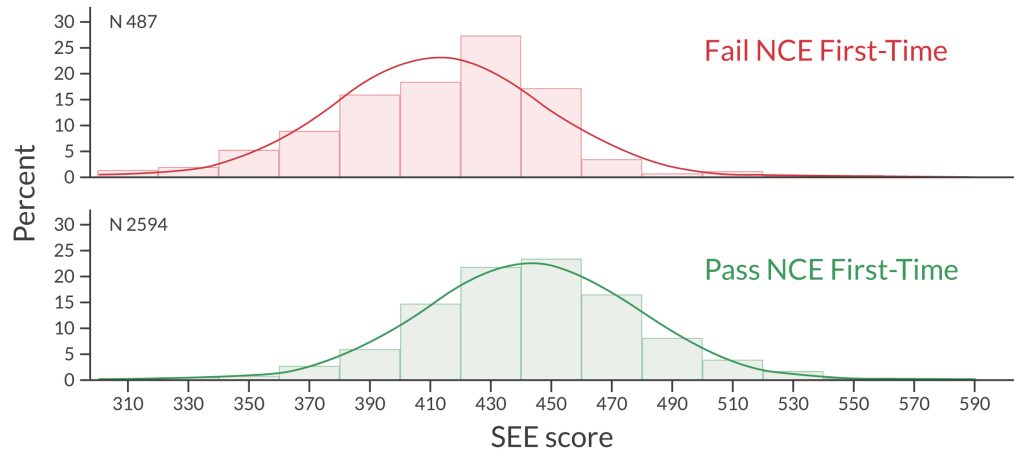They say anesthesia school is like jumping through hoops, but they’re impossibly small, lined with razor blades, and on fire.
Today we’re talking about preparing for the SEE exam, arguably one of the most important hoops standing between you and walking across the stage at graduation.
| Table of Contents:
- How is the SEE different from the NCE?
- Where do the exam questions come from?
- The SEE as the gatekeeper to graduation
- How to understand your SEE score
- The weighted domain distribution is different on the SEE and NCE
- Does the SEE really help you assess your strengths and weaknesses?
- Can I review the questions I miss on the SEE?
- Should I share exam questions to make it easier for my friends?
- How to prepare?
- How to schedule and what to expect on test day
- Your action plan
How is the SEE different from the NCE?
While the NCE (National Certification Exam) is the high-stakes exam required to become a CRNA, the SEE (Self Evaluation Exam) is a diagnostic exam nurse anesthesia students take during training. It’s useful because it:
- Predicts future success on the NCE.
- Helps students assess their strengths and weaknesses.
- Prepares students for the NCE experience.
- Helps nurse anesthesia programs understand how well their programs are preparing their students.
Before we share our analysis, here’s the basic info you need to understand about both exams.

Where do the exam questions come from?
Each exam draws from a content outline. Neither of these are exhaustive, and your exam may include questions from content areas not listed on these outlines.
Item writers reference their questions to the NBCRNA NCE and SEE Bibliography. This document includes textbooks and websites.
The NBCRNA updates the bibliography every year, so you might wonder, “What happens to the questions referenced to delisted sources?” So long as a question is still valid, it’s fair game. In fact, it’s not uncommon to see a reference removed one year only to return the next. It would make little sense for the NBCRNA to significantly modify their question banks on the basis of bibliography updates. It takes significant time and resources to develop and vet new exam questions.
The SEE as gatekeeper to graduation
The NBCRNA wanted to identify “at-risk” students who might be more likely to fail the NCE on their first attempt. In 2016, they reconfigured the SEE to increase its predictive capability about future performance on the NCE.
This prompted most nurse anesthesia programs to set a minimum SEE score as a gatekeeper to graduation. Requiring a minimum score benefits students by potentially saving them ~$1,000 for every failed NCE attempt. Likewise, it helps CRNA programs bolster their first-time pass rates. Indeed, schools that fail to achieve a predefined first-time pass threshold risk losing accreditation with the Council on Accreditation of Nurse Anesthesia Programs (COA).
According to the NBCRNA, the mean SEE score “benchmark” for graduation is 430 (SD=15), although we’ve talked with program directors who require a 450!
Where does this benchmark score come from? We can look at two groups of learners – those who pass the NCE on their first attempt and those who eventually fail the NCE (2016 – 2022).
- Average SEE score for learners who pass the NCE on their first attempt = 447.5
- Average SEE score for learners who eventually fail the NCE = 409.6
- The midpoint between these two groups = 428.6
How to understand your SEE score
Without sedating you with statistics, we need to touch on some basic concepts to help you make sense of your score. We promise to be gentle.
To see how one variable (your SEE score) might predict another variable (your first-time NCE score), we can use Pearson’s correlation coefficient (r) to look for a linear trend between these two variables. An r-value between 0 and 1 suggests that one variable positively predicts the other variable (the higher the r-value, the stronger the relationship).
Here’s the scatterplot from the NBCRNA’s regression model, where each dot represents a student’s SEE score (x-axis) and first-time NCE score (y-axis). Notice the upward trend, where a higher SEE score roughly correlates with a higher first-time NCE score.

They discovered a strong predictive value between SEE and NCE scores (r-value = 0.58 for all SEE takers).
Let’s look at the data another way by comparing the normal distribution of SEE scores for students who passed or failed the NCE. What conclusions can you reach?

Takeaway #1: Students who passed and failed the NCE on their first attempt had an average SEE score of 447.5 (SD=37.5) and 409.6 (SD=32.6), respectively.
Takeaway #2: There’s a high degree of overlap. Put simply, no SEE score guarantees that you’ll pass the NCE. Indeed, some students who scored below 400 on the SEE passed the NCE on their first attempt. Likewise, some students who scored above 450 on the SEE did NOT pass the NCE on their first attempt!
Earning a certain score on the SEE does NOT guarantee that you’ll pass the NCE.
The weighted domain distribution is not the same for the SEE and NCE
The SEE and the NCE cover the same four domains. However, the weighted domain distributions aren’t the same. This is a common point of confusion for many students and educators, and we believe this difference has a few implications.

According to the NBCRNA, the SEE weights each domain equally to give students a better understanding of their strengths and weaknesses relative to the other domains. While we understand their logic, we see it as a potential problem (in some cases) when using your SEE score as a predictive measure of NCE success.
Notice that domains 1 & 2 are overweighted relative to the NCE (+ 25%), while domain 3 is underweighted (- 29%).
Consider this scenario — You earned a 430 on the SEE (your program’s minimum requirement). You knocked the overweighted domains (1 & 2) out of the park. All other things being equal, high domain 1 & 2 scores are the only reason your total score met your program’s minimum score. You walk away with a false sense of security about passing the NCE because your domain 1 & 2 scores (remember they are overweighted relative to the NCE) are what was responsible for your “passing” SEE score.
There’s an established relationship between age and scores. Although the score differences between age groups are roughly similar, there is a noticeable trend that older students typically don’t score quite as well as younger students. There’s a similar (but more pronounced) trend on the NCE. We’re not trying to frighten anyone, but it’s worth considering if you’re an older student.
Does the SEE really help you assess your strengths and weaknesses?
We think there’s a fundamental flaw in this assertion. Here’s the information you’ll receive after you take the SEE.
- Total score
- Domain 1 (Basic Science) score
- Domain 2 (Equipment, Instrumentation & Technology) score
- Domain 3 (General Principles of Anesthesia) score
- Domain 4 (Anesthesia for Surgical Procedures and Special Populations) score
Let’s say you performed poorly in domain 1. How does this inform your plan for NCE prep? Well, it might mean you’re weak in hematologic diseases, or maybe you need to buff up in biochemistry, or perhaps you don’t understand antihypertensive agents very well.
Do you see the problem? There are so many topics in each domain, and you’ll have no idea how you did on any particular one. Knowing you’re weak in domain 1 provides nearly zero actionable insight about what to do next! This applies to all the other domains as well.
We’re often asked why we use a systems approach to our content instead of the NBCRNA domains. Well… the answer should be clear. We want to help you understand your strengths and weaknesses AND give you actionable insight about what to do next. Knowing you’re weak in domain 1 simply doesn’t cut it.
For those who want to practice with domain-specific questions, we have you covered with a growing collection of domain exams. That way, you can get the best of both worlds!
How to prepare for the SEE anesthesia exam
The next sentence is REALLY important! Students who ask how to prepare for the SEE and then how to prepare for the NCE are asking the wrong questions. Look at the content outlines for both exams. They’re nearly identical. Instead, think of SEE prep as part of the continuum of NCE prep — they’re not separate and distinct things.
Since the SEE is a diagnostic exam, some argue it’s best to take it cold because they think it’ll help you to understand your strengths and weaknesses better. If you choose this approach, make sure you can develop a plan based on your scores. If you score low in Domain 1 (Basic Science), does this provide the clarity you need to modify your study plan?
We think there’s significantly greater value in following a study plan for the SEE. The value of extra preparation (which also helps with your NCE prep) greatly outweighs the limited diagnostic benefits of taking the SEE cold. Furthermore, you’ll still see your strengths and weaknesses on your SEE report, so there’s no reason why you can’t use that to inform your NCE prep going forward. But again, domain scores aren’t useful in telling you what to learn next.
SEE prep is part of the continuum of NCE prep — they are not two different things!
Tips on preparing for the SEE
Step #1: Before you answer a single practice question, you must formulate a detailed plan that leverages the most effective study techniques. This article gives you everything you need: How to Pass Your Anesthesia Exams and the NCE.
Step #2: Sign up for a study plan in our Student Review Course. And we highly recommend you add the NCE/SEE question bank to your subscription to get extra insights into your exam readiness with peer benchmarking.
Step #3: Modify the study plan by only focusing on the Tutorials, Review Exams, and Flashcards. We suggest saving the Mock and Domain Exams for your formal NCE prep.
Step #4: If you’d benefit from a live review course (that’ll help you on the SEE and NCE), check out Boards Bootcamp.
Scheduling and what to expect on test day
You’ll schedule the SEE on the Pearson VUE website. Search for the NBCRNA, then select a location that’s best for you. Everyone has certain times of the day when they perform optimally. Keep this in mind when you schedule a time.
If you need to cancel or change your exam date, you must contact Pearson VUE (not the NBCRNA). If you don’t cancel within 24 hours of your scheduled time or arrive more than 15 minutes late, you’ll lose the money you spent, and you won’t be able to transfer your exam fee to another date. If a true emergency prevents you from taking your exam, you may petition the NBCRNA.
Here’s a video that shows you what to expect on test day.
Frequently asked questions about the SEE exam
Can I review the questions I miss on the SEE?
The NBCRNA will not allow you to review your exam or provide any information on questions you answered incorrectly. They do this to maintain exam integrity. Think back to the GRE, SAT, etc. You couldn’t review those answers for the same reasons.
Should I share exam questions to make it easier for my friends?
No! Do not share SEE (or NCE) questions with anyone — this includes other students, faculty, us, or any other exam prep company. Not only will you jeopardize your ability to take the NCE (and achieve your dream of becoming a CRNA), but it also erodes the credibility of our profession and the CRNA credential.
If you’re unsure about what’s appropriate (and what’s not), the NBCRNA lays out its expectations about exam behavior here.
Your action plan
Now that you have a clearer understanding of what lies ahead, it’s time to implement your plan. Here are your next steps:
- Decide when you want to take the SEE, and schedule your exam date (this makes it real).
- Assess your other obligations, and commit to a study plan.
- Follow our instructions in the “How to prepare” section above.
If you’re looking for a way to accelerate your success as you prepare for the SEE and NCE, check out Boards Bootcamp. This course includes a 2-day live review, additional practice questions, virtual learning sessions, extra support, and so much more. Click here to learn more.
Know someone who might benefit from this post? Use the share links below to help your friends and colleagues.







